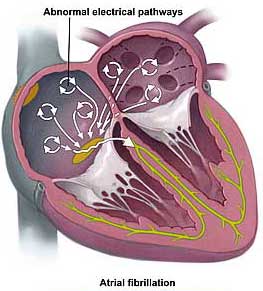Atrial Fibrillation
Atrial fibrillation is a heart rhythm disorder (arrhythmia). It usually involves a rapid heart rate, in which the upper heart chambers (atria) are stimulated to contract in a very disorganized and abnormal manner.
Causes
Arrhythmias are caused by a disruption of the normal functioning of the electrical conduction system of the heart. Normally, the atria and ventricles contract in a coordinated manner.In atrial fibrillation and flutter, the atria are stimulated to contract very quickly and differently from the normal activity originating from the sinoatrial node.
This results in ineffective and uncoordinated contraction of the atria in atrial fibrillation, and in a peculiarly organized contraction pattern in atrial flutter.This causes the walls of the atria to quiver very fast (fibrillate) instead of beating normally. As a result, the atria aren’t able to pump blood into the ventricles the way they should.The condition can be caused by impulses which are transmitted to the ventricles in an irregular fashion or by some impulses failing to be transmitted. This makes the ventricles beat irregularly, which leads to an irregular (and usually fast) pulse in atrial fibrillation.
In atrial flutter, however, the ventricles may beat rapidly, but regularly. If the atrial fibrillation/flutter is part of a condition called sick sinus syndrome, the sinus node may not work properly, and the heart rate may alternate between slow and fast. The result may be not enough blood to meet the needs of the body.AF can occur for no apparent reason. Most of the time, however, they are caused by an underlying condition that damages the heart muscle and its ability to conduct electrical impulses.
Underlying causes of atrial fibrillation and flutter include dysfunction of the sinus node (the "natural pacemaker" of the heart) and a number of heart and lung disorders, including coronary artery disease, rheumatic heart disease, mitral valve disorders, pericarditis, and others.Hyperthyroidism, hypertension, and other diseases can cause arrhythmias, as can recent heavy alcohol use (binge drinking). Some cases of atrial fibrillation or flutter occur in the setting of a heart attack or soon after surgery on the heart.Atrial fibrillation can affect both men and women. The prevalence of atrial fibrillation increases with age and varies from 1 case out of 200 persons for people younger than 60 years, to almost 9 cases out of 100 persons for people over 80 years.

Symptoms of Atrial Fibrillation
Here are some signs of atrial fibrillation. Please note that symptoms may start and stop suddenly.
• Sensation of feeling heart beat (palpitations)
• Pulse may feel rapid, racing, pounding, fluttering, or it can feel too slow
• Pulse may feel regular or irregular
• Dizziness, light-headedness
• Fainting
• Confusion
• Fatigue
• Shortness of breath
• Breathing difficulty, lying down
• Sensation of tightness in the chest
Consequences
The two most serious complications of chronic (long-term) AF are stroke and heart failure. Stroke can happen when a blood clot travels to an artery in the brain, blocking off blood flow. In AF, blood clots can form in the atria because some of the blood “pools” in the fibrillating atria instead of flowing into the ventricles. If a piece of a blood clot in the left atrium breaks off, it can travel to the brain, causing a stroke. People with AF are often treated with blood-thinning medicines to reduce the chances of developing blood clots.Heart failure is when the heart can’t pump enough blood to meet the needs of the body. AF can cause heart failure when the ventricles beat too fast and don’t have enough time to fill with blood to pump out to the body. Heart failure causes tiredness, leg swelling, and shortness of breath.
Exams and Tests
Listening to the heart with a stethoscope shows fast heart beat. The pulse may feel rapid, irregular, or both. The normal heart rate is 60 to 100, but in atrial fibrillation/flutter the heart rate may be 100 to 175. Blood pressure may be normal or low.
An ECG shows atrial fibrillation or atrial flutter. Continuous ambulatory cardiac monitoring -- Holter monitor (24 hour test) -- may be necessary because the condition is often sporadic (occurring at some times but not others).
Tests to determine the presence of underlying heart diseases may include:
• Echocardiogram
• Nuclear imaging tests
• Coronary angiography
• Exercise treadmill ECG
Treatment
In certain cases, atrial fibrillation may require emergency treatment to convert the arrhythmia to normal (sinus) rhythm. This treatment may involve either with electrical cardioversion or intravenous (IV) drugs such as dofetilide, amiodarone, or ibutilide.Long-term treatment varies depending on the cause of the atrial fibrillation or flutter. Medication may include beta-blockers, calcium channel blockers, digitalis or other medications (such as anti-arrhythmic drugs), which slow the heartbeat or the conduction of the impulse from the atria to the ventricles.Blood thinners, such as heparin or Coumadin, may be given to reduce the risk of a thromboembolic event such as a stroke.Some selected patients with atrial fibrillation, rapid heart rates, and intolerance to medication may require a catheter procedure on the atria called radiofrequency ablation.For some patients with atrial flutter, radiofrequency ablation is the current treatment of choice. Some patients with atrial fibrillation and rapid heart rates may need the radiofrequency ablation done not on the atria, but directly on the AV junction (i.e., the area that normally filters the impulses coming from the atria before they proceed to the ventricles).Ablation of the AV junction leads to complete heart block. Treatment for this condition requires a permanent pacemaker.
Acknowledgement
Heart Rhythm Specialists of South Florida gives special thanks to the National Library of Medicine and National Heart Lung and Blood Institute whose Web sites aided in the research of the patient educational material provided above.






